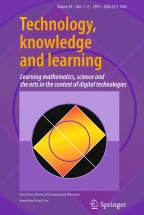Explore related subjects
Discover the latest articles, news and stories from top researchers in related subjects.References
Abelson, H. & diSessa, A. (1980). Turtle Geometry: The Computer as a Medium for Exploring Mathematics. Cambridge, MA: MIT Press.
Clayson, J. (1990). Visual Modeling with Logo: A Structural Approach to Seeing. Cambridge, MA: MIT Press.
Confrey, J. and Costa, S. (In press). A critique of the selection of “Mathematical Objects” is central metaphor for advanced mathematical thinking. Intentional Journal of Computers for Mathematical Learning.
diSessa, A., Holyes, C., Noss, R. and Edwards, L. (Eds.) (1996). Computers and Exploratory Learning. Heidelberg: Springer Verlag.
Dorfler, W. (1993). Computer use and views of the mind. In C. Keitel and K. Ruthven (Eds.), Learning from Computers: Mathematics Education and Technology (pp. 159–186). New York: Springer-Verlag.
Dubinsky, E. and Harel, G. (1992). The nature of the process conception of function. In G. Harel and E. Dubinsky (Eds.), The Concept of Function. Washington, DC: Mathematical Association of America.
Greene, Andree. Logo Art. Shown in art exhibitions in Montreal and elsewhere.
Harel, Idit (1991). Children Designers. NJ: Ablex.
Hoyles, C. and Noss, R. (Eds.) (1992). Learning Mathematics and Logo. Cambridge, MA: MIT Press.
Kafai, Y. (1995). Minds In Play: Computer Game Design as a Context for Children's Learning. NJ: Erlbaum.
Kahneman, D. and Tversky, A. (1982). Judgment Under Uncertainty. Cambridge: Cambridge University Press.
Kaput, J. J. (1992). Technology and Mathematics Education. In A. C. Grouws (Ed.), Handbook of Research and Teaching in Mathematics. New York: Macmillan.
Lawler, R. (1981). The progressive construction of mind, Cognitive Science, 5: 1–30.
Lawler, R. (1985). Computer Experience and Cognitive Development. NY: Wiley.
Noss, R. and Hoyles, C. (1996). Windows on Mathematical Meaning: Learning Cultures and Computers. Dordrecht: Kluwer.
Noss, R. (In press). On static and dynamic algebra systems. In J. Kaput (Ed.), Early Algebra.
Papert, S. (1980). Mindstorms: Children, Computers and Powerful Ideas. New York: Basic Books, Inc.
Papert, S. (1986). Beyond the cognitive: The other face of mathematics. Proceedings of the Nineteenth International Conference for the Psychology of Mathematics Education, Plenary Lectures, 51–58.
Papert, S. (1992). The Children's Machine: Rethinking School in the Age of the Computer. New York: Basic Books, Inc.
Papert, S. (In press) The Connected Family: Bridging the Digital Generation Gap. Atlanta: Longstreet Press, Inc.
Resnick, M. (1996). New paradigms for computing, new paradigms for thinking. In A. disessa, C. Hoyles, R. Noss, and L. Edwards (Eds.), The Design of Computation Media to Support Exploratory Learning. (pp. 31–44).
Resnick, M. (1994). Turtles, Termites, and Traffic Jams: Explorations in Massively Parallel Microworlds. Cambridge, MA: MIT Press.
Resnick, M., Ocko, S. and Rapert, S. (1988). LEDO, logo, and design. Children's Environments Quarterly, 5(4): 14–18.
Sfard, A. and Leron, U. (1996). Just give me a computer and I will move the earth: Programming as a catalyst of a cultural revolution in the mathematics classroom. International Journal of Computers for Mathematical Learning.
Sfard, A. (1992). Operational origins of mathematical objects and the quandary of reification: The case of function. In G. Harel and E. Dubinsky (Eds.), The Concept of Function (pp. 59–84). Washington, DC: Mathematical Association of America.
Sfard, A. (1994). Reification as the birth of metaphor. For the Learning of Mathematics, 14(1): 44–55.
Shaughnessy, J. M. (1992). Research in probability and statistics. In A. G. Grouws (Ed.), Handbook of Research and Teching in Mathematics. New York: Macmillan.
Solomon, C. Computer Environments for Children: A Reflection on Theories of Learning. Cambridge MA: MIT Press.
Weir, S. (1987). Cultivating Minds: A Logo Casebook. New York: Harper & Row.
Wilensky, U. (1996). Modeling Rugby: Kick First, Generalize later? International Journal of Computers for Mathematical Learning, 1(1).
Wilensky, U. (1991). Abstract meditations on the concrete and concrete implications for mathematics education. In. I. Harel and S. Papert (Eds.), Constructionism. Norwood, NJ: Ablex Publishing Corp.
Wilensky, U. (1993). Connected Mathematics: Building Concrete Relationships with Mathematical Knowledge. Doctoral dissertation. Cambridge, MA: MIT Media Laboratory.
Wilensky, U. (1995). Paradox, programming and learning probability. Journal of Mathematical Behavior. 14(2).
Author information
Authors and Affiliations
Rights and permissions
About this article
Cite this article
Papert, S. An exploration in the space of mathematics educations. Int J Comput Math Learning 1, 95–123 (1996). https://doi.org/10.1007/BF00191473
Issue Date:
DOI: https://doi.org/10.1007/BF00191473
